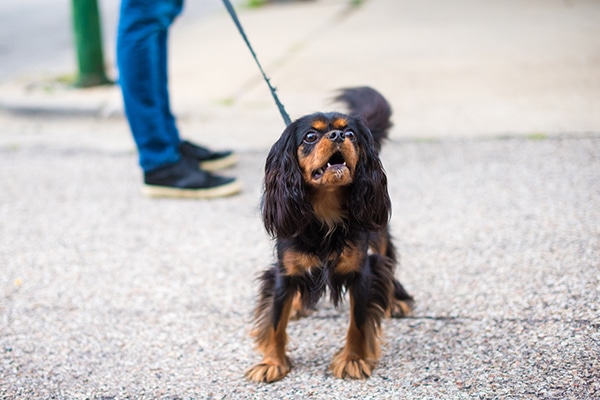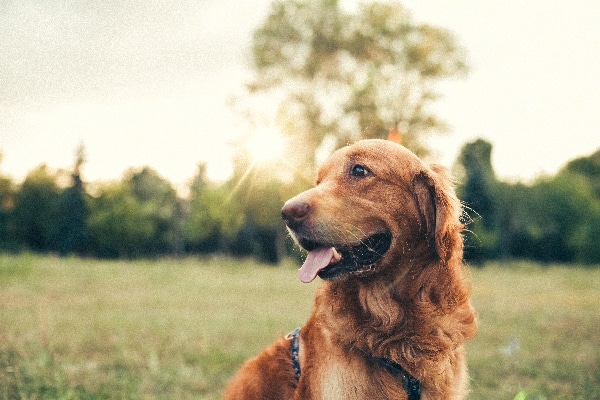The post 10 Summer Dangers for Dogs — And How to Avoid Them by Sassafras Lowrey appeared first on Dogster. Copying over entire articles infringes on copyright laws. You may not be aware of it, but all of these articles were assigned, contracted and paid for, so they aren’t considered public domain. However, we appreciate that you like the article and would love it if you continued sharing just the first paragraph of an article, then linking out to the rest of the piece on Dogster.com.
The dog days of summer are opportunities for fun in the sun with Fido, but the hot summer weather also brings the following top health and safety concerns.
1. Walking dogs on hot pavement

Make sure the pavement isn’t too hot for your dog in the summer. Photography ©Page Light Studios | Thinkstock.
Walks are a great way to keep your dog physically and mentally exercised, but in the summer months they come with some specific health concerns. Emmy award-winning veterinarian Dr. Jeff Werber cautions that dog parents should pay special attention to the pavement and how hot it is. “Remember, even after dark the pavement retains heat and can injure your dog’s pads,” he says.
Not sure if it’s too hot? Place your hand on the pavement. If you have to pull your own hand away because it’s too hot for you, then it’s too hot for your dog’s paws.
Plan your dog walks for early morning hours, late afternoon or early evening, and always avoid having your dog out in the midday heat. If you must walk your dog in the heat of the day invest in booties to protect your dog’s sensitive pads from the hot pavement.
2. Riding in cars
When driving with your dog in the summer, always keep the air conditioning on for the safety and comfort of your dog. “If the car is too hot for you, then it’s too hot for your dog,” Dr. Werber explains.
Cars are dangerous places for dogs in summer heat, and dogs should never be left in a parked car, even in the shade or in a parking garage. Even with the windows cracked, temperatures inside a car increase rapidly and can quickly be fatal to your dog.
3. Leaving dogs outside
Increasingly, cities and states are instituting new legal protections for dogs that prohibit them being left outside in extreme cold or hot temperatures. In Pennsylvania, for example, people who leave dogs outside in over 90-degrees Fahrenheit heat could face steep fines or even jail time.
If for some reason your dog must be left outside, Dr. Werber advises that your dog must be provided free access to water. In addition, your dog must be able to get either natural shade or consistent shade created by an awning or other structure.
4. Brachycephalic dogs overheating
While hot weather can be dangerous for all dogs, there are particular breeds more at risk in hot weather due to breathing problems — dogs with more pushed-in faces (brachycephalic dogs) such as: Pugs, French Bulldogs, Boston Terriers, Boxers, Staffordshire Bull Terriers, Bulldogs, Shih Tzus, Pekingese, Affenpinschers, Japanese Chins, Cavalier King Charles Spaniels, Lhasa Apsos and Brussels Griffons.
These dogs are better off inside in air conditioning during the hottest of summer months.
Japanese Chins are particularly at risk in hot weather. Dr. Werber also cautions that “Pekingese and Lhasa Apso have more thickness around their necks than other breeds and are more inclined to having pharyngeal stenosis. This can make breathing and panting more challenging, which is why you often hear them ‘snoring.’ These breeds are more prone to overheating.”
Before traveling, check with the airlines on any pet restrictions during warm weather months.
5. Heatstroke

Be on the lookout for heatstroke in dogs during warmer weather. Photography ©martin-dm | iStock / Getty Images Plus.
Dogs pant to cool down, but ongoing panting can be a sign that your dog is overheating and in distress. If your dog has been in the heat, is incessantly panting, has slowed down, appears extremely tired and doesn’t want to move, Dr. Werber cautions that the dog could be experiencing heatstroke, which can be fatal.
If you think your dog has heatstroke, get him to a veterinarian right away. While en route, Dr. Werber says to dribble water into your dog’s mouth to keep it moist and try to soak down the feet as well as the body, which should help to bring down your dog’s overall body temperature. He advises that “room temperature water is best — you don’t want to cool them down too quickly.”
6. Not drinking enough water
Year-round, but especially in the summer heat, it’s essential that your dog has constant access to fresh water. Because risk of dehydration in dogs increases in the summer heat, make sure your dog stays hydrated while you are out enjoying the warm weather. Always carry water for your dog and have a travel water bowl with you for hikes and outings, but also for neighborhood walks. Take frequent breaks to give your dog an opportunity to drink. Dr. Werber also encourages dog guardians to “soak a bandanna in water and freeze it overnight. Wrap it around your dog’s neck before a walk.”
At home, up the amount of water you give your dog, especially if you are away from the house all day. A dog water fountain is even better, as it provides lots of fresh water all day long.
7. Shaving your dog could actually be harmful
A fur coat might look hot in the summer heat, but your dog’s fur actually keeps them cool. AKC executive secretary, Gina DiNardo, explains that while it might be tempting to give your pup a cool summer trim or shave, doing so might actually be harmful.
“People tend to think that doublecoated breeds suffer more in hot weather because of the massive amounts of coat,” she says. “However, this is not the case. Their coat traps the air closest to the skin and keeps it the same temperature as their ideal body temperature. Also, if you shave a dog down to the skin, you not only increase the risk of heatstroke, but sunburn, too.”
Gina also advises that dogs who have hair instead of fur such as Poodles and Bichons can be shaved in the summer, but to keep enough coat to protect the dog’s skin from the sun.
8. Sunburn
There are a variety of canine sunscreens on the market that can help to protect your dog’s sensitive skin from sun damage. Don’t use human sunscreens on dogs, as they usually include zinc or other ingredients not safe for dogs to ingest (since dogs lick everything!).
Sunscreen is important for areas of your dog’s body that are more exposed, such as right above the nose, the belly, abdomen and groin area. Short-coated and light-colored dogs are especially at risk of sunburns. Hairless dogs should always wear sunscreen when out in the summer.
9. Ticks
Beyond being a painful nuisance, ticks can transmit serious disease to your dog including Lyme disease and Rocky Mountain spotted fever. Make sure your dog is up-to-date on flea/tick prevention, and know what diseases ticks in your area of the country spread. Carry a tick remover, and check your dog for ticks after walks.
10. Swimming concerns
Yes, dogs can drown. No, not all dogs know how to swim. Even if your dog does know how to swim, he can get tired and, unlike humans, he doesn’t know how to do the dead man’s float to rest. Always fit your pup with a canine life vest to support his mid-section and hindquarters to keep him safe. The handle at the top also makes it easy to pull your dog out of the water if you are on a boat or paddleboard.
If you have a pool, teach your dog how to safely get in and out, so he doesn’t drown trying to get out. Dogs in pools should also be wearing a canine life vest. Brachycephalic dogs, puppies, seniors, dogs with short legs and long backs and barrel-chested dogs, in particular, should always wear a canine life vest.
Thumbnail: Photography ©Victoria Rak | Tuff Photo.
About the author
Sassafras Lowrey is an award-winning author and Certified Trick Dog Instructor. Sassafras’ forthcoming books include: “TRICKS IN THE CITY: For Daring Dogs and the Humans That Love Them,” “Healing/Heeling,” and Bedtime Stories for Rescue Dogs: William To The Rescue. Learn more at SassafrasLowrey.com
Editor’s note: This article appeared in Dogster magazine. Have you seen the new Dogster print magazine in stores? Or in the waiting room of your vet’s office? Subscribe now to get Dogster magazine delivered straight to you!
Read more about summer and dogs on Dogster.com:
The post 10 Summer Dangers for Dogs — And How to Avoid Them by Sassafras Lowrey appeared first on Dogster. Copying over entire articles infringes on copyright laws. You may not be aware of it, but all of these articles were assigned, contracted and paid for, so they aren’t considered public domain. However, we appreciate that you like the article and would love it if you continued sharing just the first paragraph of an article, then linking out to the rest of the piece on Dogster.com.
No comments:
Post a Comment